CO2 Enrichment in Protected Agriculture: A Bibliometric Review on Greenhouses, Controlled Environment Systems, and Vertical Farms—Part 1
Abstract
1. Introduction
- (1)
- What is the current state of knowledge on CO2 enrichment in greenhouses and other controlled agricultural systems?
- (2)
- What are the main trends, limitations, and future developments in this field?
- (3)
- Which specific knowledge gaps can be identified to guide future research?
2. Materials and Methods
2.1. Definition of the Search Equation
2.2. Preliminary Results
2.3. Analysis of the Initial Database
2.4. Performance Analysis
2.5. Scientific Mapping of the Field of Knowledge
3. Results and Discussion
3.1. Number of Documents Published
3.2. Types of Documents Published
3.3. Areas of Knowledge in Which the Published Papers Are Located
3.4. Documents Published by Country
3.5. Co-Authorship Network by Country
3.6. Network of Citations by Country
3.7. Bibliographic Linkage Between Countries
3.8. Leading Institutions in the Production of Academic Documents
3.9. Leading Authors in Academic Production
3.10. Co-Authorship Network Between Authors
3.11. Citation Network Between Authors
3.12. Network of Bibliographic Coupling Among Authors
3.13. Journals Selected by Authors for Publication of Papers
3.14. Citation Network Between Journals
3.15. Citation Network Between Publication Sources
3.16. Top Ten Most Relevant Articles
3.17. Top Ten Recently Published Articles
3.18. Most Used Keywords
3.19. Keyword Co-Occurrence Network
3.20. Multiple Correspondence Analysis: Knowledge Gaps and Future Directions in CO2 Enrichment for Protected Agriculture
4. Conclusions and Recommendations
5. Methodological Innovation and Limitations
Author Contributions
Funding
Data Availability Statement
Acknowledgments
Conflicts of Interest
References
- Villagran, E.; Bojacá, C.; Akrami, M. Contribution to the Sustainability of Agricultural Production in Greenhouses Built on Slope Soils: A Numerical Study of the Microclimatic Behavior of a Typical Colombian Structure. Sustainability 2021, 13, 4748. [Google Scholar] [CrossRef]
- Villagran, E.; Toro-Tobón, G.; Velázquez, F.A.; Estrada-Bonilla, G.A. Integration of IoT Technologies and High-Performance Phenotyping for Climate Control in Greenhouses and Mitigation of Water Deficit: A Study of High-Andean Oat. AgriEngineering 2024, 6, 4011–4040. [Google Scholar] [CrossRef]
- Gruda, N.; Bisbis, M.; Tanny, J. Influence of Climate Change on Protected Cultivation: Impacts and Sustainable Adaptation Strategies—A Review. J. Clean. Prod. 2019, 225, 481–495. [Google Scholar] [CrossRef]
- Ortiz, G.A.; Chamorro, A.N.; Acuña-Caita, J.F.; López-Cruz, I.L.; Villagran, E. Calibration and Implementation of a Dynamic Energy Balance Model to Estimate the Temperature in a Plastic-Covered Colombian Greenhouse. AgriEngineering 2023, 5, 2284–2302. [Google Scholar] [CrossRef]
- Villagrán-Munar, E.A.; Jaramillo, J.E. Microclimatic Behavior of a Screen House Proposed for Horticultural Production in Low-Altitude Tropical Climate Conditions. Comun. Sci. 2020, 11, e3350. [Google Scholar] [CrossRef]
- Teitel, M.; Vitoshkin, H.; Geoola, F.; Karlsson, S.; Stahl, N. Greenhouse and Screenhouse Cover Materials: Literature Review and Industry Perspective. Acta Hortic. 2018, 31–44. [Google Scholar] [CrossRef]
- Flores-Velázquez, J.; Rojano, F.; Aguilar-Rodríguez, C.E.; Villagran, E.; Villarreal-Guerrero, F. Greenhouse Thermal Effectiveness to Produce Tomatoes Assessed by a Temperature-Based Index. Agronomy 2022, 12, 1158. [Google Scholar] [CrossRef]
- Ghani, S.; El-Bialy, E.M.A.A.; Bakochristou, F.; Mohamed Rashwan, M.; Mohamed Abdelhalim, A.; Mohammad Ismail, S.; Ben, P. Experimental and Numerical Investigation of the Thermal Performance of Evaporative Cooled Greenhouses in Hot and Arid Climates. Sci. Technol. Built Environ. 2020, 26, 141–160. [Google Scholar] [CrossRef]
- Aguilar-Rodríguez, C.E.; Flores-Velázquez, J.; Villagrán, E.; Ramos-Banderas, J.-Á.; Hernández-Bocanegra, C.-A.; Pérez-Inocencio, J. Impact of Crop Height on the Thermal Gradient in a Heated Greenhouse: A Numerical Analysis. DYNA 2024, 99, 1–7. [Google Scholar]
- Nakabo, Y. Design and Control of Smart Plant Factory. In Smart Plant Factory; Springer: Singapore, 2018; pp. 51–55. [Google Scholar]
- Fox, J.A.; Adriaanse, P.; Stacey, N.T. Greenhouse Energy Management: The Thermal Interaction of Greenhouses with the Ground. J. Clean. Prod. 2019, 235, 288–296. [Google Scholar] [CrossRef]
- Zhang, Y.; Yasutake, D.; Hidaka, K.; Okayasu, T.; Kitano, M.; Hirota, T. Crop-Localised CO2 Enrichment Improves the Microclimate, Photosynthetic Distribution and Energy Utilisation Efficiency in a Greenhouse. J. Clean. Prod. 2022, 371, 133465. [Google Scholar] [CrossRef]
- Villagrán, E.; Romero-Perdomo, F.; Numa-Vergel, S.; Galindo-Pacheco, J.R.; Salinas-Velandia, D.A. Life Cycle Assessment in Protected Agriculture: Where Are We Now, and Where Should We Go Next? Horticulturae 2023, 10, 15. [Google Scholar] [CrossRef]
- Salinas-Velandia, D.A.; Romero-Perdomo, F.; Numa-Vergel, S.; Villagrán, E.; Donado-Godoy, P.; Galindo-Pacheco, J.R. Insights into Circular Horticulture: Knowledge Diffusion, Resource Circulation, One Health Approach, and Greenhouse Technologies. Int. J. Environ. Res. Public Health 2022, 19, 12053. [Google Scholar] [CrossRef] [PubMed]
- Nomura, K.; Saito, M.; Tada, I.; Yasutake, D.; Kimura, K.; Kitano, M. Simulating the Photosynthetic and Annual-Yield Enhancement of a Row-Planted Greenhouse Tomato Canopy Through Diffuse Covering, CO2 Enrichment, and High-Wire Techniques. Horticulturae 2024, 10, 1210. [Google Scholar] [CrossRef]
- Villagrán, E.; Flores-Velazquez, J.; Akrami, M.; Bojacá, C. Microclimatic Evaluation of Five Types of Colombian Greenhouses Using Geostatistical Techniques. Sensors 2022, 22, 3925. [Google Scholar] [CrossRef]
- Kimball, B.A. Crop Responses to Elevated CO2 and Interactions with H2O, N, and Temperature. Curr. Opin. Plant Biol. 2016, 31, 36–43. [Google Scholar] [CrossRef]
- Flores-Velazquez, J.; Akrami, M.; Villagrán, E. The Role of Radiation in the Modelling of Crop Evapotranspiration from Open Field to Indoor Crops. Agronomy 2022, 12, 2593. [Google Scholar] [CrossRef]
- Villagrán Munar, E.A.; Gómez Arias, L.Y.; Gómez Latorre, D.A.; Rodríguez Giraldo, Y.; Chacón Garzón, I.E.; Numa Vergel, S.J.; Velásquez Ayala, F.A.; Espitia González, J.J.; Salinas Velandia, D.A.; Galindo Pacheco, J.R. Estrategias de Adaptación y Mitigación Al Cambio Climático En Sistemas de Producción Agrícola: Un Enfoque Desde La Agricultura Protegida y Técnicas de Biotecnología Para El Manejo Del Cultivo; Corporación Colombiana de Investigación Agropecuaria (AGROSAVIA): Bogota, Colombia, 2023. [Google Scholar]
- Chen, D.; Mei, Y.; Liu, Q.; Wu, Y.; Yang, Z. Carbon Dioxide Enrichment Promoted the Growth, Yield, and Light-use Efficiency of Lettuce in a Plant Factory with Artificial Lighting. Agron. J. 2021, 113, 5196–5206. [Google Scholar] [CrossRef]
- Becker, C.; Kläring, H.-P. CO2 Enrichment Can Produce High Red Leaf Lettuce Yield While Increasing Most Flavonoid Glycoside and Some Caffeic Acid Derivative Concentrations. Food Chem. 2016, 199, 736–745. [Google Scholar] [CrossRef]
- Thomas, R.T.; Prentice, I.C.; Graven, H.; Ciais, P.; Fisher, J.B.; Hayes, D.J.; Huang, M.; Huntzinger, D.N.; Ito, A.; Jain, A. Increased Light-use Efficiency in Northern Terrestrial Ecosystems Indicated by CO2 and Greening Observations. Geophys. Res. Lett. 2016, 43, 11–339. [Google Scholar] [CrossRef]
- Holley, J.; Mattson, N.; Ashenafi, E.; Nyman, M. The Impact of CO2 Enrichment on Biomass, Carotenoids, Xanthophyll, and Mineral Content of Lettuce (Lactuca sativa L.). Horticulturae 2022, 8, 820. [Google Scholar] [CrossRef]
- Noh, K.; Jeong, B.R. Optimizing Temperature and Photoperiod in a Home Cultivation System to Program Normal, Delayed, and Hastened Growth and Development Modes for Leafy Oak-Leaf and Romaine Lettuces. Sustainability 2021, 13, 10879. [Google Scholar] [CrossRef]
- Singh, H.; Poudel, M.R.; Dunn, B.L.; Fontanier, C.; Kakani, G. Effect of Greenhouse CO2 Supplementation on Yield and Mineral Element Concentrations of Leafy Greens Grown Using Nutrient Film Technique. Agronomy 2020, 10, 323. [Google Scholar] [CrossRef]
- Nord, E.A.; Jaramillo, R.E.; Lynch, J.P. Response to Elevated CO2 in the Temperate C3 Grass Festuca Arundinaceae across a Wide Range of Soils. Front. Plant Sci. 2015, 6, 95. [Google Scholar] [CrossRef]
- Ahmed, H.A.; Yu-Xin, T.; Qi-Chang, Y. Optimal Control of Environmental Conditions Affecting Lettuce Plant Growth in a Controlled Environment with Artificial Lighting: A Review. S. Afr. J. Bot. 2020, 130, 75–89. [Google Scholar] [CrossRef]
- Yasutake, D.; Tanioka, H.; Ino, A.; Takahashi, A.; Yokoyama, T.; Mori, M.; Kitano, M.; Miyauchi, K. Dynamic Evaluation of Natural Ventilation Characteristics of a Greenhouse with CO2 Enrichment. Acad. J. Agric. Res. 2017, 5, 312–319. [Google Scholar]
- Allen, L.H.; Kimball, B.A.; Bunce, J.A.; Yoshimoto, M.; Harazono, Y.; Baker, J.T.; Boote, K.J.; White, J.W. Fluctuations of CO2 in Free-Air CO2 Enrichment (FACE) Depress Plant Photosynthesis, Growth, and Yield. Agric. For. Meteorol. 2020, 284, 107899. [Google Scholar] [CrossRef]
- Vermeulen, P. Alternative Sources of CO2 for the Greenhouse Horticulture. In Proceedings of the 2nd International Symposium Energy Challenges Mechanics (ISECM2), Brisbane, Australia, 17 August 2014; pp. 19–21. [Google Scholar]
- Villagrán, E.A.; Baeza Romero, E.J.; Bojacá, C.R. Transient CFD Analysis of the Natural Ventilation of Three Types of Greenhouses Used for Agricultural Production in a Tropical Mountain Climate. Biosyst. Eng. 2019, 188, 288–304. [Google Scholar] [CrossRef]
- Marttila, M.P.; Uusitalo, V.; Linnanen, L.; Mikkilä, M.H. Agro-Industrial Symbiosis and Alternative Heating Systems for Decreasing the Global Warming Potential of Greenhouse Production. Sustainability 2021, 13, 9040. [Google Scholar] [CrossRef]
- Carrión-Mero, P.; Montalván-Burbano, N.; Herrera-Narváez, G.; Morante-Carballo, F. Geodiversity and Mining towards the Development of Geotourism: A Global Perspective. Int. J. Des. Nat. Ecodyn. 2021, 16, 191–201. [Google Scholar] [CrossRef]
- Espitia, J.J.; Velázquez, F.A.; Rodriguez, J.; Gomez, L.; Baeza, E.; Aguilar-Rodríguez, C.E.; Flores-Velazquez, J.; Villagran, E. Solar Energy Applications in Protected Agriculture: A Technical and Bibliometric Review of Greenhouse Systems and Solar Technologies. Agronomy 2024, 14, 2791. [Google Scholar] [CrossRef]
- Merigó, J.M.; Mas-Tur, A.; Roig-Tierno, N.; Ribeiro-Soriano, D. A Bibliometric Overview of the Journal of Business Research between 1973 and 2014. J. Bus. Res. 2015, 68, 2645–2653. [Google Scholar] [CrossRef]
- Osareh, F. Bibliometrics, Citation Analysis and Co-Citation Analysis: A Review of Literature I. Libri 1996, 46, 149–158. [Google Scholar] [CrossRef]
- Liao, H.; Tang, M.; Luo, L.; Li, C.; Chiclana, F.; Zeng, X.-J. A Bibliometric Analysis and Visualization of Medical Big Data Research. Sustainability 2018, 10, 166. [Google Scholar] [CrossRef]
- Rocha, G.A.O.; Medina, A.N.C.; Arias, L.G.; Caita, J.F.A.; Villagran, E. Análisis Sobre La Actividad Científica Referente a Las Estrategias de Climatización Pasiva Usada En Invernaderos: Parte 2: Análisis Técnico. Cienc. Lat. Rev. Cient. Multidiscip. 2022, 6, 2220–2245. [Google Scholar]
- Pico-Saltos, R.; Carrión-Mero, P.; Montalván-Burbano, N.; Garzás, J.; Redchuk, A. Research Trends in Career Success: A Bibliometric Review. Sustainability 2021, 13, 4625. [Google Scholar] [CrossRef]
- Yeung, A.W.K.; Goto, T.K.; Leung, W.K. A Bibliometric Review of Research Trends in Neuroimaging. Curr. Sci. 2017, 112, 725–734. [Google Scholar] [CrossRef]
- Merigó, J.M.; Yang, J.-B. A Bibliometric Analysis of Operations Research and Management Science. Omega 2017, 73, 37–48. [Google Scholar] [CrossRef]
- Santander, M.; Chica, V.; Correa, H.A.M.; Rodríguez, J.; Villagran, E.; Vaillant, F.; Escobar, S. Unravelling Cocoa Drying Technology: A Comprehensive Review of the Influence on Flavor Formation and Quality. Foods 2025, 14, 721. [Google Scholar] [CrossRef]
- Villagran, E.; Rocha, G.A.O.; Mojica, L.; Florez-Velazquez, J.; Aguilar, C.E.; Gomez, L.; Gomez, D.; Antolinez, E.; Numa, S. Scientific Analysis of Cut Flowers: A Review of the Main Technical Issues Developed. Ornam. Hortic. 2024, 30, e242699. [Google Scholar] [CrossRef]
- Santillan-Angeles, A.; Mendoza-Perez, C.; Villagrán, E.; Garcia, F.; Flores-Velazquez, J. Bibliometric Analysis of Hydrothermal Wastewater Treatment in the Last Two Decades. Water 2025, 17, 746. [Google Scholar] [CrossRef]
- Haruna, E.U.; Asiedu, W.K.; Bello, L.O. Mapping the Knowledge Domain of Natural Capital and Sustainability: A Bibliometric Analysis Using the Scopus Database for Future Research Direction. Dev. Sustain. Econ. Financ. 2024, 5, 100035. [Google Scholar] [CrossRef]
- Villagran, E.; Espitia, J.J.; Velázquez, F.A.; Rodriguez, J. Solar Dryers: Technical Insights and Bibliometric Trends in Energy Technologies. AgriEngineering 2024, 6, 4041–4063. [Google Scholar] [CrossRef]
- Yao, L.; Zhang, Y.; Zhao, C.; Zhao, F.; Bai, S. The PRISMA 2020 Statement: A System Review of Hospital Preparedness for Bioterrorism Events. Int. J. Environ. Res. Public Health 2022, 19, 16257. [Google Scholar] [CrossRef]
- Villagran, E.; Espitia, J.J.; Amado, G.; Rodriguez, J.; Gomez, L.; Velasquez, J.F.; Gil, R.; Baeza, E.; Aguilar, C.E.; Akrami, M. CO2 Enrichment in Protected Agriculture: A Systematic Review of Greenhouses, Controlled Environment Systems, and Vertical Farms—Part 2. Sustainability 2025, 17, 2809. [Google Scholar] [CrossRef]
- Cobo, M.J.; López-Herrera, A.G.; Herrera-Viedma, E.; Herrera, F. An Approach for Detecting, Quantifying, and Visualizing the Evolution of a Research Field: A Practical Application to the Fuzzy Sets Theory Field. J. Informetr. 2011, 5, 146–166. [Google Scholar] [CrossRef]
- Donthu, N.; Kumar, S.; Mukherjee, D.; Pandey, N.; Lim, W.M. How to Conduct a Bibliometric Analysis: An Overview and Guidelines. J. Bus. Res. 2021, 133, 285–296. [Google Scholar] [CrossRef]
- Baker, H.K.; Kumar, S.; Pandey, N. Forty Years of the Journal of Futures Markets: A Bibliometric Overview. J. Futur. Mark. 2021, 41, 1027–1054. [Google Scholar] [CrossRef]
- Tunger, D.; Eulerich, M. Bibliometric Analysis of Corporate Governance Research in German-Speaking Countries: Applying Bibliometrics to Business Research Using a Custom-Made Database. Scientometrics 2018, 117, 2041–2059. [Google Scholar] [CrossRef]
- Lam, W.H.; Lam, W.S.; Jaaman, S.H.; Lee, P.F. Bibliometric Analysis of Information Theoretic Studies. Entropy 2022, 24, 1359. [Google Scholar] [CrossRef]
- Rocha, G.A.O.; Vergel, S.J.N.; Arias, L.G.; Giraldo, Y.R.; Villagran, E. La Técnica Del Cultivo Sin Suelo y Su Contribución Al Mejoramiento Tecnológico de La Agricultura Bajo Cubierta: Un Análisis Bibliométrico. Cienc. Lat. Rev. Cient. Multidiscip. 2022, 6, 7053–7074. [Google Scholar]
- Koo, J.K.; Hwang, H.S.; Hwang, J.H.; Park, E.W.; Yu, J.; Yun, J.H.; Hwang, S.Y.; Choi, H.E.; Hwang, S.J. Supplemental Lighting and CO2 Enrichment on the Growth, Fruit Quality, and Yield of Cucumber. Hortic. Environ. Biotechnol. 2024, 66, 77–85. [Google Scholar] [CrossRef]
- Zhou, Y.; Mahmoud Ali, H.S.; Xi, J.; Yao, D.; Zhang, H.; Li, X.; Yu, K.; Zhao, F. Response of Photosynthetic Characteristics and Yield of Grape to Different CO2 Concentrations in a Greenhouse. Front. Plant Sci. 2024, 15, 1378749. [Google Scholar] [CrossRef]
- Han, X.; Sun, Y.; Chen, J.; Wang, Z.; Qi, H.; Liu, Y.; Liu, Y. Effects of CO2 Enrichment on Carbon Assimilation, Yield and Quality of Oriental Melon Cultivated in a Solar Greenhouse. Horticulturae 2023, 9, 561. [Google Scholar] [CrossRef]
- Joshi, A.; Saxena, A.; Das, S.K. Effect of Greenhouse Microclimate on Crop Performance. In Protected Cultivation; Apple Academic Press: Palm Bay, FL, USA, 2024; pp. 135–159. [Google Scholar]
- Du, B.; Shukla, M.K.; Yang, X.; Du, T. Enhanced Fruit Yield and Quality of Tomato by Photosynthetic Bacteria and CO2 Enrichment under Reduced Irrigation. Agric. Water Manag. 2023, 277, 108106. [Google Scholar] [CrossRef]
- Li, X.; Zhao, J.; Shang, M.; Song, H.; Zhang, J.; Xu, X.; Zheng, S.; Hou, L.; Li, M.; Xing, G. Physiological and Molecular Basis of Promoting Leaf Growth in Strawberry (Fragaria ananassa Duch.) by CO2 Enrichment. Biotechnol. Biotechnol. Equip. 2020, 34, 905–917. [Google Scholar] [CrossRef]
- Jang, Y.; Mun, B.; Do, K.; Um, Y.; Chun, C. Effects of Photosynthetic Photon Flux and Carbon Dioxide Concentration on the Photosynthesis and Growth of Grafted Pepper Transplants during Healing and Acclimatization. Hortic. Environ. Biotechnol. 2014, 55, 387–396. [Google Scholar] [CrossRef]
- Stacey, N.; Fox, J.; Hildebrandt, D. Reduction in Greenhouse Water Usage through Inlet CO2 Enrichment. AIChE J. 2018, 64, 2324–2328. [Google Scholar] [CrossRef]
- Wang, H.; Zhao, J.; Duan, J.; Wang, M.; Dong, Z. Greenhouse CO2 Control Based on Improved Genetic Algorithm and Fuzzy Neural Network. In Proceedings of the 2018 2nd IEEE Advanced Information Management, Communicates, Electronic and Automation Control Conference (IMCEC), Xi’an, China, 25–27 May 2018; pp. 1537–1540. [Google Scholar]
- Nurmalisa, M.; Tokairin, T.; Kumazaki, T.; Takayama, K.; Inoue, T. CO2 Distribution under CO2 Enrichment Using Computational Fluid Dynamics Considering Photosynthesis in a Tomato Greenhouse. Appl. Sci. 2022, 12, 7756. [Google Scholar] [CrossRef]
- Saxe, H.; Christensen, O.V. Effects of Carbon Dioxide with and without Nitric Oxide Pollution on Growth, Morphogenesis and Production Time of Pot Plants. Environ. Pollut. Ser. A Ecol. Biol. 1985, 38, 159–169. [Google Scholar] [CrossRef]
- Osborne, C.P.; Beerling, D.J. Sensitivity of Tree Growth to a High CO2 Environment: Consequences for Interpreting the Characteristics of Fossil Woods from Ancient ‘Greenhouse’ Worlds. Palaeogeogr. Palaeoclimatol. Palaeoecol. 2002, 182, 15–29. [Google Scholar] [CrossRef]
- Bao, J.; Zhao, J.; Bi, X.T. CO2 Adsorption and Desorption for CO2 Enrichment at Low-Concentrations Using Zeolite 13X. Chem. Ing. Tech. 2023, 95, 143–150. [Google Scholar] [CrossRef]
- Tang, C.; Gao, X.; Shao, Y.; Wang, L.; Liu, K.; Gao, R.; Che, D. Investigation on the Rotary Regenerative Adsorption Wheel in a New Strategy for CO2 Enrichment in Greenhouse. Appl. Therm. Eng. 2022, 205, 118043. [Google Scholar] [CrossRef]
- Takeya, S.; Muromachi, S.; Maekawa, T.; Yamamoto, Y.; Mimachi, H.; Kinoshita, T.; Murayama, T.; Umeda, H.; Ahn, D.-H.; Iwasaki, Y. Design of Ecological CO2 Enrichment System for Greenhouse Production Using TBAB + CO2 Semi-Clathrate Hydrate. Energies 2017, 10, 927. [Google Scholar] [CrossRef]
- Zhang, Y.; Yasutake, D.; Hidaka, K.; Kimura, K.; Okayasu, T.; Kitano, M.; Hirota, T. Eco-Friendly Strategy for CO2 Enrichment Performance in Commercial Greenhouses Based on the CO2 Spatial Distribution and Photosynthesis. Sci. Rep. 2023, 13, 17277. [Google Scholar] [CrossRef]
- Kennebeck, E.J.; Meng, Q. Mustard ‘Amara’ Benefits from Superelevated CO2 While Adapting to Far-Red Light over Time. HortScience 2024, 59, 139–145. [Google Scholar] [CrossRef]
- Hao, X.; Wang, Q.; Khosla, S. Responses of a Long Greenhouse Tomato Crop to Summer CO2 Enrichment. Can. J. Plant Sci. 2006, 86, 1395–1400. [Google Scholar] [CrossRef]
- Son, K.-H.; Sim, H.-S.; Lee, J.-K.; Lee, J. Precise Sensing of Leaf Temperatures for Smart Farm Applications. Horticulturae 2023, 9, 518. [Google Scholar] [CrossRef]
- Moreno, J.V.R.; Pinna-Hernández, M.G.; Molina, J.A.S.; Fernández, M.D.F.; Hernández, J.C.L.; Fernández, F.G.A. Carbon Capture from Biomass Flue Gases for CO2 Enrichment in Greenhouses. Heliyon 2024, 10, e23274. [Google Scholar] [CrossRef]
- Tartachnyk, I.I.; Blanke, M.M. Photosynthesis and Transpiration of Tomato and CO2 Fluxes in a Greenhouse under Changing Environmental Conditions in Winter. Ann. Appl. Biol. 2007, 150, 149–156. [Google Scholar] [CrossRef]
- Bailey, B.J.; Chalabi, Z.S.; Aikman, D.P.; Cockshull, K.E. Improved Strategies for Controlling CO2 Enrichment in Tomato Greenhouses. In Proceedings of the International Conference on Greenhouse Technologies 443, Tel Aviv, Israel, 12 May 1996; pp. 155–162. [Google Scholar] [CrossRef]
- Bergstrand, K.-J.; Suthaparan, A.; Mortensen, L.M.; Gislerød, H.G. Photosynthesis in Horticultural Plants in Relation to Light Quality and CO2 Concentration. Eur. J. Hortic. Sci. 2016, 81, 237–242. [Google Scholar] [CrossRef]
- de los Á Mejía-Bentancourt, F.; Sánchez-Del Castillo, F.; Colinas-León, M.T.B. Enriquecimiento Carbónico en Plántulas de Tomate Para Incrementar el Número de Flores y Frutos Por Planta. Rev. Fitotec. Mex. 2024, 47, 285. [Google Scholar]
- Effat, M.B.; Shafey, H.M.; Nassib, A.M. Solar Greenhouses Can Be Promising Candidate for CO2 Capture and Utilization: Mathematical Modeling. Int. J. Energy Environ. Eng. 2015, 6, 295–308. [Google Scholar] [CrossRef]
- Nijs, I.; Roy, J.; Salager, J.; Fabreguettes, J. Elevated CO2 Alters Carbon Fluxes in Early Successional Mediterranean Ecosystems. Glob. Change Biol. 2000, 6, 981–994. [Google Scholar] [CrossRef]
- Cooper, P.I.; Fuller, R.J. A Transient Model of the Interaction between Crop, Environment and Greenhouse Structure for Predicting Crop Yield and Energy Consumption. J. Agric. Eng. Res. 1983, 28, 401–417. [Google Scholar] [CrossRef]
- Rezende, F.C.; Frizzone, J.A.; Oliveira, R.F.; de Pereira, A.S. CO2 and Irrigation in Relation to Yield and Water Use of the Bell Pepper Crop. Sci. Agric. 2003, 60, 7–12. [Google Scholar] [CrossRef]
- Perone, C.; Orsino, M.; La Fianza, G.; Brunetti, L.; Giametta, F.; Catalano, P. CO2 Use and Energy Efficiency in Closed Plant Production System by Means of Mini-Air Handling Unit. In Proceedings of the International Conference on Safety, Health and Welfare in Agriculture and Agro-Food Systems, Ragusa, Italy, 16–19 September 2020; pp. 506–515. [Google Scholar]
- Osman, M.; Qaryouti, M.; Alharbi, S.; Alghamdi, B.; Al-Soqeer, A.; Alharbi, A.; Almutairi, K.; Abdelaziz, M.E. Impact of CO2 Enrichment on Growth, Yield and Fruit Quality of F1 Hybrid Strawberry Grown under Controlled Greenhouse Condition. Horticulturae 2024, 10, 941. [Google Scholar] [CrossRef]
- Haghighi, M.; Golabdar, S.; Abolghasemi, R.; Kappel, N. CO2 Enrichment Changed N Metabolism of Tomatoes under Salinity Stress. Sci. Hortic. 2022, 305, 111412. [Google Scholar] [CrossRef]
- Draoui, B.; Bounaama, F.; Boulard, T.; Bibi-Triki, N. In-Situ Modelisation of a Greenhouse Climate Including Sensible Heat, Water Vapour and CO2 Balances. In EPJ Web of Conferences; EDP Sciences: Les Ulis, France, 2013; Volume 45, p. 1023. [Google Scholar]
- Duan, C. Analyses of Scientific Collaboration Networks among Authors, Institutions, and Countries in FinTech Studies: A Bibliometric Review. FinTech 2024, 3, 249–273. [Google Scholar] [CrossRef]
- Rocha, G.A.O.; Pichimata, M.A.; Villagran, E. Research on the Microclimate of Protected Agriculture Structures Using Numerical Simulation Tools: A Technical and Bibliometric Analysis as a Contribution to the Sustainability of Under-Cover Cropping in Tropical and Subtropical Countries. Sustainability 2021, 13, 10433. [Google Scholar] [CrossRef]
- Oliński, M.; Krukowski, K.; Sieciński, K. Bibliometric Overview of ChatGPT: New Perspectives in Social Sciences. Publications 2024, 12, 9. [Google Scholar] [CrossRef]
- Montalván-Burbano, N.; Pérez-Valls, M.; Plaza-Úbeda, J. Analysis of Scientific Production on Organizational Innovation. Cogent Bus. Manag. 2020, 7, 1745043. [Google Scholar] [CrossRef]
- Batagelj, V. On Fractional Approach to Analysis of Linked Networks. Scientometrics 2020, 123, 621–633. [Google Scholar] [CrossRef]
- Ahlgren, P.; Jarneving, B. Bibliographic Coupling, Common Abstract Stems and Clustering: A Comparison of Two Document-Document Similarity Approaches in the Context of Science Mapping. Scientometrics 2008, 76, 273–290. [Google Scholar] [CrossRef]
- Li, Y.; Ding, Y.; Li, D.; Miao, Z. Automatic Carbon Dioxide Enrichment Strategies in the Greenhouse: A Review. Biosyst. Eng. 2018, 171, 101–119. [Google Scholar] [CrossRef]
- Moon, T.; Choi, H.-Y.; Jung, D.-H.; Chang, S.-H.; Son, J.-E. Prediction of CO2 Concentration via Long Short-Term Memory Using Environmental Factors in Greenhouses. Korean J. Hortic. Sci. Technol. 2020, 38, 201–209. [Google Scholar] [CrossRef]
- Hidaka, K.; Nakahara, S.; Yasutake, D.; Zhang, Y.; Okayasu, T.; Dan, K.; Kitano, M.; Sone, K. Crop-Local CO2 Enrichment Improves Strawberry Yield and Fuel Use Efficiency in Protected Cultivations. Sci. Hortic. 2022, 301, 111104. [Google Scholar] [CrossRef]
- Urban, L.; Barthélémy, L.; Bearez, P.; Pyrrha, P. Effect of Elevated CO2 on Photosynthesis and Chlorophyll Fluorescence of Rose Plants Grown at High Temperature and High Photosynthetic Photon Flux Density. Photosynthetica 2001, 39, 275–281. [Google Scholar] [CrossRef]
- Mortensen, L.M. CO2 Enrichment in Greenhouses. Crop Responses. Sci. Hortic. 1987, 33, 1–25. [Google Scholar] [CrossRef]
- Pan, T.; Ding, J.; Qin, G.; Wang, Y.; Xi, L.; Yang, J.; Li, J.; Zhang, J.; Zou, Z. Interaction of Supplementary Light and CO2 Enrichment Improves Growth, Photosynthesis, Yield, and Quality of Tomato in Autumn through Spring Greenhouse Production. HortScience 2019, 54, 246–252. [Google Scholar] [CrossRef]
- Villagran, E.; Ortiz, G.A.; Mojica, L.; Flores-Velasquez, J.; Aguilar, C.E.; Gomez, L.; Antolinez, E.; Numa, S. Bibliometric Study of Cut Flower Research. Ornam. Hortic. 2023, 29, 500–514. [Google Scholar] [CrossRef]
- Morante-Carballo, F.; Montalván-Burbano, N.; Carrión-Mero, P.; Jácome-Francis, K. Worldwide Research Analysis on Natural Zeolites as Environmental Remediation Materials. Sustainability 2021, 13, 6378. [Google Scholar] [CrossRef]
- Nomura, K.; Kaneko, T.; Iwao, T.; Kitayama, M.; Goto, Y.; Kitano, M. Hybrid AI Model for Estimating the Canopy Photosynthesis of Eggplants. Photosynth. Res. 2023, 155, 77–92. [Google Scholar] [CrossRef] [PubMed]
- Takahashi, A.; Yasutake, D.; Hidaka, K.; Ono, S.; Kitano, M.; Hirota, T.; Yokoyama, G.; Nakamura, T.; Toro, M. Yield and Photosynthesis Related to Growth Forms of Two Strawberry Cultivars in a Plant Factory with Artificial Lighting. HortScience 2024, 59, 394–399. [Google Scholar] [CrossRef]
- Pham, D.T.; Amin, N.A.I.; Yasutake, D.; Hirai, Y.; Ozaki, T.; Koga, M.; Hidaka, K.; Kitano, M.; Vo, H.B.; Okayasu, T. Development of Plant Phenotyping System Using Pan Tilt Zoom Camera and Verification of Its Validity. Comput. Electron. Agric. 2024, 227, 109579. [Google Scholar] [CrossRef]
- Kaneko, T.; Nomura, K.; Yasutake, D.; Iwao, T.; Okayasu, T.; Ozaki, Y.; Mori, M.; Hirota, T.; Kitano, M. A Canopy Photosynthesis Model Based on a Highly Generalizable Artificial Neural Network Incorporated with a Mechanistic Understanding of Single-Leaf Photosynthesis. Agric. For. Meteorol. 2022, 323, 109036. [Google Scholar] [CrossRef]
- Yokoyama, G.; Ono, S.; Yasutake, D.; Hidaka, K.; Hirota, T. Diurnal Changes in the Stomatal, Mesophyll, and Biochemical Limitations of Photosynthesis in Well-Watered Greenhouse-Grown Strawberries. Photosynthetica 2023, 61, 1–12. [Google Scholar] [CrossRef]
- Ono, S.; Yasutake, D.; Kimura, K.; Kengo, I.; Teruya, Y.; Hidaka, K.; Yokoyama, G.; Hirota, T.; Kitano, M.; Okayasu, T. Effect of Microclimate and Photosynthesis on Strawberry Reproductive Growth in a Greenhouse: Using Cumulative Leaf Photosynthesis as an Index to Predict the Time of Harvest. J. Hortic. Sci. Biotechnol. 2024, 99, 223–232. [Google Scholar] [CrossRef]
- Nakai, H.; Yasutake, D.; Hidaka, K.; Miyoshi, Y.; Eguchi, T.; Yokoyama, G.; Hirota, T. Sink Strength Dynamics Based on Potential Growth and Carbohydrate Accumulation in Strawberry Fruit. HortScience 2024, 59, 1505–1510. [Google Scholar] [CrossRef]
- Nakai, H.; Yasutake, D.; Hidaka, K.; Nomura, K.; Eguchi, T.; Yokoyama, G.; Hirota, T. Starch Serves as an Overflow Product in the Regulation of Carbon Allocation in Strawberry Leaves in Response to Photosynthetic Activity. Plant Growth Regul. 2023, 101, 875–882. [Google Scholar] [CrossRef]
- Watanabe, S.; Moriyuki, S.; Matsuo, K.; Hidaka, K.; Nakajima, Y. Effects of Air and Root Zone Temperature on the Distribution of 13C Photosynthates in Asparagus Plants. In Proceedings of the IV Asian Horticultural Congress-AHC2023 1404, Tokyo, Japan, 28–31 August 2023; pp. 1093–1098. [Google Scholar]
- Naito, H.; Kawasaki, Y.; Hidaka, K.; Higashide, T.; Misumi, M.; Ota, T.; Lee, U.; Takahashi, M.; Hosoi, F.; Nakagawa, J. Effect of Air Temperature on Each Fruit Growth and Ripening Stage of Strawberry ‘Koiminori’. Int. Agrophys. 2024, 38, 195–202. [Google Scholar] [CrossRef]
- Miyoshi, Y.; Hidaka, K.; Yin, Y.-G.; Suzui, N.; Kurita, K.; Kawachi, N. Non-Invasive 11C-Imaging Revealed No Change in the Dynamics of Photosynthates Translocation of Strawberry in Response to Increasing Daylight Integrals Under Low Light Conditions. In Proceedings of the XXXI International Horticultural Congress (IHC2022): International Symposium on Advances in Berry Crops 1381, Angers, France, 14–20 August 2022; pp. 89–96. [Google Scholar]
- Miyoshi, Y.; Hidaka, K.; Okayasu, T.; Yasutake, D.; Kitano, M. Effects of Local CO2 Enrichment on Strawberry Cultivation during the Winter Season. Environ. Control Biol. 2017, 55, 165–170. [Google Scholar] [CrossRef]
- Mortensen, L.M.; Ringsevjen, F. Semi-Closed Greenhouse Photosynthesis Measurements—A Future Standard in Intelligent Climate Control. Eur. J. Hortic. Sci. 2020, 85, 219–225. [Google Scholar] [CrossRef]
- Mortensen, L.M.; Gislerød, H.R. The Effect of High CO2 Concentrations on Diurnal Photosynthesis at High Daytime Temperatures in Small Stands of Cut Roses. Eur. J. Hortic. Sci. 2012, 77, 163–169. [Google Scholar] [CrossRef]
- Mortensen, L.M.; Gislerød, H.R. Night Temperature Drop Affects the Diurnal Photosynthetic Rhythm of Kalanchoe blossfeldiana. Eur. J. Hortic. Sci. 2018, 83, 160–165. [Google Scholar] [CrossRef]
- Åkerström, A.M.; Mortensen, L.M.; Rusten, B.; Gislerød, H.R. Biomass Production and Removal of Ammonium and Phosphate by Chlorella Sp. in Sludge Liquor at Natural Light and Different Levels of Temperature Control. Springerplus 2016, 5, 676. [Google Scholar] [CrossRef]
- Mortensen, L.M.; Gislerød, H.R. The Growth of Chlorella Sorokiniana as Influenced by CO2, Light, and Flue Gases. J. Appl. Phycol. 2016, 28, 813–820. [Google Scholar] [CrossRef]
- Mortensen, L.M.; Gislerød, H.R. The Growth of Chlamydomonas Reinhardtii as Influenced by High CO2 and Low O2 in Flue Gas from a Silicomanganese Smelter. J. Appl. Phycol. 2015, 27, 633–638. [Google Scholar] [CrossRef]
- Arief, M.A.A.; Nugroho, A.P.; Putro, A.W.; Sutiarso, L.; Cho, B.-K.; Okayasu, T. Development and Application of a Low-Cost 3-Dimensional (3D) Reconstruction System Based on the Structure from Motion (SfM) Approach for Plant Phenotyping. J. Biosyst. Eng. 2024, 49, 326–336. [Google Scholar] [CrossRef]
- Dzaky, M.A.F.; Nugroho, A.P.; Prasetyatama, Y.D.; Sutiarso, L.; Falah, M.A.F.; Okayasu, T. Control of Vapor Pressure Deficit (VPD) in Micro-Plant Factory (McPF) to Enhanced Spinach Microgreens Growth. Sci. Hortic. 2024, 332, 113229. [Google Scholar] [CrossRef]
- Nakai, H.; Yasutake, D.; Kimura, K.; Kengo, I.; Hidaka, K.; Eguchi, T.; Hirota, T.; Okayasu, T.; Ozaki, Y.; Kitano, M. Dynamics of Carbon Export from Leaves as Translocation Affected by the Coordination of Carbohydrate Availability in Field Strawberry. Environ. Exp. Bot. 2022, 196, 104806. [Google Scholar] [CrossRef]
- Baiyin, B.; Xiang, Y.; Shao, Y.; Son, J.E.; Tagawa, K.; Yamada, S.; Yamada, M.; Yang, Q. Multi-Omics Analysis of the Effects of Hydroponic Nutrient Flow Environment on Lignin Biosynthesis in Lettuce Root. Sci. Hortic. 2024, 338, 113728. [Google Scholar] [CrossRef]
- Jung, D.H.; Hwang, I.; Son, J.E. Three-Dimensional Estimation of Greenhouse-Grown Mango Photosynthesis with Different CO2 Enrichment Heights. Hortic. Environ. Biotechnol. 2022, 63, 823–834. [Google Scholar] [CrossRef]
- Shin, J.; Hwang, I.; Kim, D.; Kim, J.; Kim, J.H.; Son, J.E. Waning Advantages of CO2 Enrichment on Photosynthesis and Productivity Due to Accelerated Phase Transition and Source-Sink Imbalance in Sweet Pepper. Sci. Hortic. 2022, 301, 111130. [Google Scholar] [CrossRef]
- Kwon, S.; Kim, D.; Moon, T.; Son, J.E. Evaluation of the Light Use Efficiency and Water Use Efficiency of Sweet Peppers Subjected to Supplemental Interlighting in Greenhouses. Hortic. Environ. Biotechnol. 2023, 64, 605–614. [Google Scholar] [CrossRef]
- Derrien, M.; Badr, A.; Gosselin, A.; Desjardins, Y.; Angers, P. Optimization of a Sustainable Purification Protocol for Lutein and Chlorophyll from Spinach By-Products by a Saponification Procedure Using Box Behnken Design and Desirability Function. Food Bioprod. Process. 2019, 116, 54–62. [Google Scholar] [CrossRef]
- Shang, L.; Gaudreau, L.; Martel, M.; Michaud, D.; Pepin, S.; Gosselin, A. Effects of CO2 Enrichment, LED Inter-Lighting, and High Plant Density on Growth of Nicotiana Benthamiana Used as a Host to Express Influenza Virus Hemagglutinin H1. Hortic. Environ. Biotechnol. 2018, 59, 637–648. [Google Scholar] [CrossRef]
- Zekki, H.; Gary, C.; Gosselin, A.; Gauthier, L. Validation of a Photosynthesis Model through the Use of the CO2 Balance of a Greenhouse Tomato Canopy. Ann. Bot. 1999, 84, 591–598. [Google Scholar] [CrossRef]
- Lim, E.; Seo, G.-S.; Hwang, I.; Shin, I.-K.; Oh, M.-M. Light Environment Analysis and Production of Red Leaf Lettuce in Greenhouses with Flexible Solar Cells. Hortic. Sci. Technol. 2024, 42, 225–233. [Google Scholar] [CrossRef]
- Kim, D.; Moon, T.; Kwon, S.; Hwang, I.; Son, J.E. Supplemental Inter-Lighting with Additional Far-Red to Red and Blue Light Increases the Growth and Yield of Greenhouse Sweet Peppers (Capsicum annuum L.) in Winter. Hortic. Environ. Biotechnol. 2023, 64, 83–95. [Google Scholar] [CrossRef]
- Kim, J.; Kang, W.H.; Kim, D.; Hwang, I.; Lee, H.J.; Son, J.E. Evaluation and Estimation of Light Interception and Photosynthetic Rate of Lettuce Plants Grown Under LEDs Using 3D-Scanned Plant Modelling. In Proceedings of the International Symposium on Advanced Technologies and Management for Innovative Greenhouses: GreenSys2019 1296, Angers, France, 16–20 June 2019; pp. 411–416. [Google Scholar]
- Yamaura, H.; Kanno, K.; Iwasaki, Y.; Nakano, A.; Isozaki, M. Controlling Growth and Carbohydrate Utilization of Tomato Seedlings through Day-Night Temperature Difference and High Light Intensity under Elevated CO2 Conditions. Sci. Hortic. 2023, 322, 112427. [Google Scholar] [CrossRef]
- Eguchi, M.; Enjoji, A.; Yamaguchi, J.; Iwasaki, Y.; Kitaya, Y. An Alternative Method for Growth Analysis of Lettuce Grown in a Plant Factory with Artificial Lighting Using Projected Canopy Area and Fresh Mass. In Proceedings of the XXXI International Horticultural Congress (IHC2022): International Symposium on Advances in Vertical Farming 1369, Angers, France, 14 August 2022; pp. 243–248. [Google Scholar]
- Jung, D.H.; Lee, J.W. Growth Characteristics of Bell Pepper and Tomato Hydroponically Cultivated in Growth Media Containing Different NaCl Concentrations in Raw Water on Reclaimed Lands. Korean J. Hortic. Sci. Technol. 2023, 41, 164–176. [Google Scholar] [CrossRef]
- Lee, I.B.; Jung, D.H.; Kang, S.B.; Hong, S.S.; Yi, P.H.; Jeong, S.T.; Park, J.M. Changes in Growth, Fruit Quality, and Leaf Characteristics of Apple Tree (Malus Domestica Borkh.’Fuji’) Grown under Elevated CO2 and Temperature Conditions. Korean J. Hortic. Sci. Technol. 2023, 41, 113–124. [Google Scholar] [CrossRef]
- Carchiolo, V.; Grassia, M.; Malgeri, M.; Mangioni, G. Co-Authorship Networks Analysis to Discover Collaboration Patterns among Italian Researchers. Future Internet 2022, 14, 187. [Google Scholar] [CrossRef]
- Barabâsi, A.-L.; Jeong, H.; Néda, Z.; Ravasz, E.; Schubert, A.; Vicsek, T. Evolution of the Social Network of Scientific Collaborations. Phys. A Stat. Mech. Its Appl. 2002, 311, 590–614. [Google Scholar] [CrossRef]
- Zhang, J.Z.; Srivastava, P.R.; Sharma, D.; Eachempati, P. Big Data Analytics and Machine Learning: A Retrospective Overview and Bibliometric Analysis. Expert Syst. Appl. 2021, 184, 115561. [Google Scholar] [CrossRef]
- Maltseva, D.; Batagelj, V. Citation and Bibliographic Coupling between Authors in the Field of Social Network Analysis. J. Data Inf. Sci. 2024, 9, 110–154. [Google Scholar] [CrossRef]
- Pandey, D.K.; Hassan, M.K.; Kumari, V.; Ben Zaied, Y.; Rai, V.K. Mapping the Landscape of FinTech in Banking and Finance: A Bibliometric Review. Res. Int. Bus. Financ. 2024, 67, 102116. [Google Scholar] [CrossRef]
- Biscaro, C.; Giupponi, C. Co-Authorship and Bibliographic Coupling Network Effects on Citations. PLoS ONE 2014, 9, e99502. [Google Scholar] [CrossRef]
- Aria, M.; Cuccurullo, C. Bibliometrix: An R-Tool for Comprehensive Science Mapping Analysis. J. Informetr. 2017, 11, 959–975. [Google Scholar] [CrossRef]
- Carrión-Mero, P.; Montalván-Burbano, N.; Morante-Carballo, F.; Quesada-Román, A.; Apolo-Masache, B. Worldwide Research Trends in Landslide Science. Int. J. Environ. Res. Public Health 2021, 18, 9445. [Google Scholar] [CrossRef] [PubMed]
- Feng, Y.; Warner, M.E.; Zhang, Y.; Sun, J.; Fu, F.-X.; Rose, J.M.; Hutchins, D.A. Interactive Effects of Increased PCO2, Temperature and Irradiance on the Marine Coccolithophore Emiliania huxleyi (Prymnesiophyceae). Eur. J. Phycol. 2008, 43, 87–98. [Google Scholar] [CrossRef]
- Taub, D.R.; Seemann, J.R.; Coleman, J.S. Growth in Elevated CO2 Protects Photosynthesis against High-temperature Damage. Plant Cell Environ. 2000, 23, 649–656. [Google Scholar] [CrossRef]
- Niklaus, P.A.; Leadley, P.W.; Stöcklin, J.; Körner, C. Nutrient Relations in Calcareous Grassland under Elevated CO2. Oecologia 1998, 116, 67–75. [Google Scholar] [CrossRef] [PubMed]
- Whiting, G.J.; Gandy, E.L.; Yoch, D.C. Tight Coupling of Root-Associated Nitrogen Fixation and Plant Photosynthesis in the Salt Marsh Grass Spartina alterniflora and Carbon Dioxide Enhancement of Nitrogenase Activity. Appl. Environ. Microbiol. 1986, 52, 108–113. [Google Scholar] [CrossRef]
- Stewart, J.D.; Hoddinott, J. Photosynthetic Acclimation to Elevated Atmospheric Carbon Dioxide and UV Irradiation in Pinus Banksiana. Physiol. Plant. 1993, 88, 493–500. [Google Scholar] [CrossRef]
- Calvet, J.-C.; Soussana, J.-F. Modelling CO2-Enrichment Effects Using an Interactive Vegetation SVAT Scheme. Agric. For. Meteorol. 2001, 108, 129–152. [Google Scholar] [CrossRef]
- Xu, S.; Zhu, X.; Li, C.; Ye, Q. Effects of CO2 Enrichment on Photosynthesis and Growth in Gerbera Jamesonii. Sci. Hortic. 2014, 177, 77–84. [Google Scholar] [CrossRef]
- Lee, S.Y.; Jung, S.H.; Kim, Y.J. A Study on Okra (Abelmoschus esculentus) and Thanksgiving Cactus (Schlumbergera truncata) for the Introduction as Rooftop Greenhouse Plants. In Proceedings of the IV Asian Horticultural Congress-AHC2023 1404, Tokyo, Japan, 28 August 2023; pp. 301–308. [Google Scholar]
- Chen, W.-H.; You, F. MPC for the Indoor Climate Control and Energy Optimization of a Building-Integrated Rooftop Greenhouse Systems. IFAC-PapersOnLine 2024, 58, 164–169. [Google Scholar] [CrossRef]
- Suzuki, K.; Yamakawa, T.; Itoh, S.; Ohishi, N.; Kiriiwa, Y. Determination of Fossil-Derived Carbon Ratio of Tomato Plants in Greenhouse with CO2 Enrichment Using Biobased Content Method. Sci. Hortic. 2024, 327, 112818. [Google Scholar] [CrossRef]
- Alahmadi, S.M.; Al-Garadi, K.; Alghamdi, A.A. CO2 Utilization for Environmental Innovation: From Waste Stream to Sustainable Solutions. In Proceedings of the SPE Energy Transition Symposium, Houston, TX, USA, 12–14 August 2024; p. D011S007R003. [Google Scholar]
- Hong, T.; Cai, Z.; Li, R.; Liu, J.; Li, J.; Wang, Z.; Zhang, Z. Effects of Water and Nitrogen Coupling on Watermelon Growth, Photosynthesis and Yield under CO2 Enrichment. Agric. Water Manag. 2022, 259, 107229. [Google Scholar] [CrossRef]
- Dannehl, D.; Kläring, H.-P.; Schmidt, U. Light-Mediated Reduction in Photosynthesis in Closed Greenhouses Can Be Compensated for by CO2 Enrichment in Tomato Production. Plants 2021, 10, 2808. [Google Scholar] [CrossRef] [PubMed]
- Boondum, S.; Chulaka, P.; Kaewsorn, P.; Nukaya, T.; Takagaki, M.; Yamori, W. Carbon Dioxide (CO2) Enrichment in Greenhouse Enhanced Growth and Productivity of Tomato (Solanum lycopersicum L.) during Winter. In Proceedings of the International Forum on Horticultural Product Quality 1245, Bangkok, Thailand, 22 August 2018; pp. 61–64. [Google Scholar]
- Li, T.; Ji, Y.H.; Zhang, M.; Sha, S.; Jiang, Y.Q. Tomato Photosynthetic Rate Prediction Models under Interaction of CO2 Enrichments and Soil Moistures. Trans. CSAM 2015, 46, 208–214. [Google Scholar]
- Porras, M.E.; Lorenzo, P.; Medrano, E.; Sánchez-González, M.J.; Otálora-Alcón, G.; Piñero, M.C.; Del Amor, F.M.; Sánchez-Guerrero, M.C. Photosynthetic Acclimation to Elevated CO2 Concentration in a Sweet Pepper (Capsicum annuum) Crop under Mediterranean Greenhouse Conditions: Influence of the Nitrogen Source and Salinity. Funct. Plant Biol. 2017, 44, 573–586. [Google Scholar] [CrossRef]
- Baba, M.Y.; Maroto, J.V.; San Batoutista, A.; Pascual, B.; Lopez, S.; Baixauli, C. Agronomic Response of Sweet Pepper (Capsicum annuum L.) to CO2 Enrichment in Greenhouses with Static Ventilation. In Proceedings of the International Symposium on Greenhouse Cooling 719, Almería, Spain, 24–27 April 2006; pp. 521–528. [Google Scholar]
- Bailey, B.J. Optimal Control of Carbon Dioxide Enrichment in Tomato Greenhouses. In Proceedings of the International Symposium on Design and Environmental Control of Tropical and Subtropical Greenhouses 578, Taichung, Taiwan, 15–18 April 2001; pp. 63–69. [Google Scholar]
- Overdieck, D. Effects of Atmospheric CO2 Enrichment on CO2 Exchange Rates of Beech Stands in Small Model Ecosystems. Water. Air Soil Pollut. 1993, 70, 259–277. [Google Scholar] [CrossRef]
- Mortensen, L.M. Effect of Carbon Dioxide Concentration on Biomass Production and Partitioning in Betula Pubescens Ehrh. Seedlings at Different Ozone and Temperature Regimes. Environ. Pollut. 1995, 87, 337–343. [Google Scholar] [CrossRef]
- Zhang, M.; Li, T.; Ji, Y.; Sha, S. Optimization of CO2 Enrichment Strategy Based on BPNN for Tomato Plants in Greenhouse. Trans. Chin. Soc. Agric. Mach. 2015, 46, 239–245. [Google Scholar]
- Zheng, S.; Yang, L.; Zheng, H.; Wu, J.; Zhou, Z.; Tian, J. Identification of Hub Genes and Physiological Effects of Overexpressing the Photosynthesis-Related Gene Soly720 in Tomato under High-CO2 Conditions. Int. J. Mol. Sci. 2024, 25, 757. [Google Scholar] [CrossRef]
- Herrera-Franco, G.; Montalván-Burbano, N.; Carrión-Mero, P. Bravo-Montero, Lady Worldwide Research on Socio-Hydrology: A Bibliometric Analysis. Water 2021, 13, 1283. [Google Scholar] [CrossRef]
- Villagran, E.; Espitia, J.J.; Rodriguez, J.; Gomez, L.; Amado, G.; Baeza, E.; Aguilar-Rodríguez, C.E.; Flores-Velazquez, J.; Akrami, M.; Gil, R. Use of Lighting Technology in Controlled and Semi-Controlled Agriculture in Greenhouses and Protected Agriculture Systems—Part 1: Scientific and Bibliometric Analysis. Sustainability 2025, 17, 1712. [Google Scholar] [CrossRef]

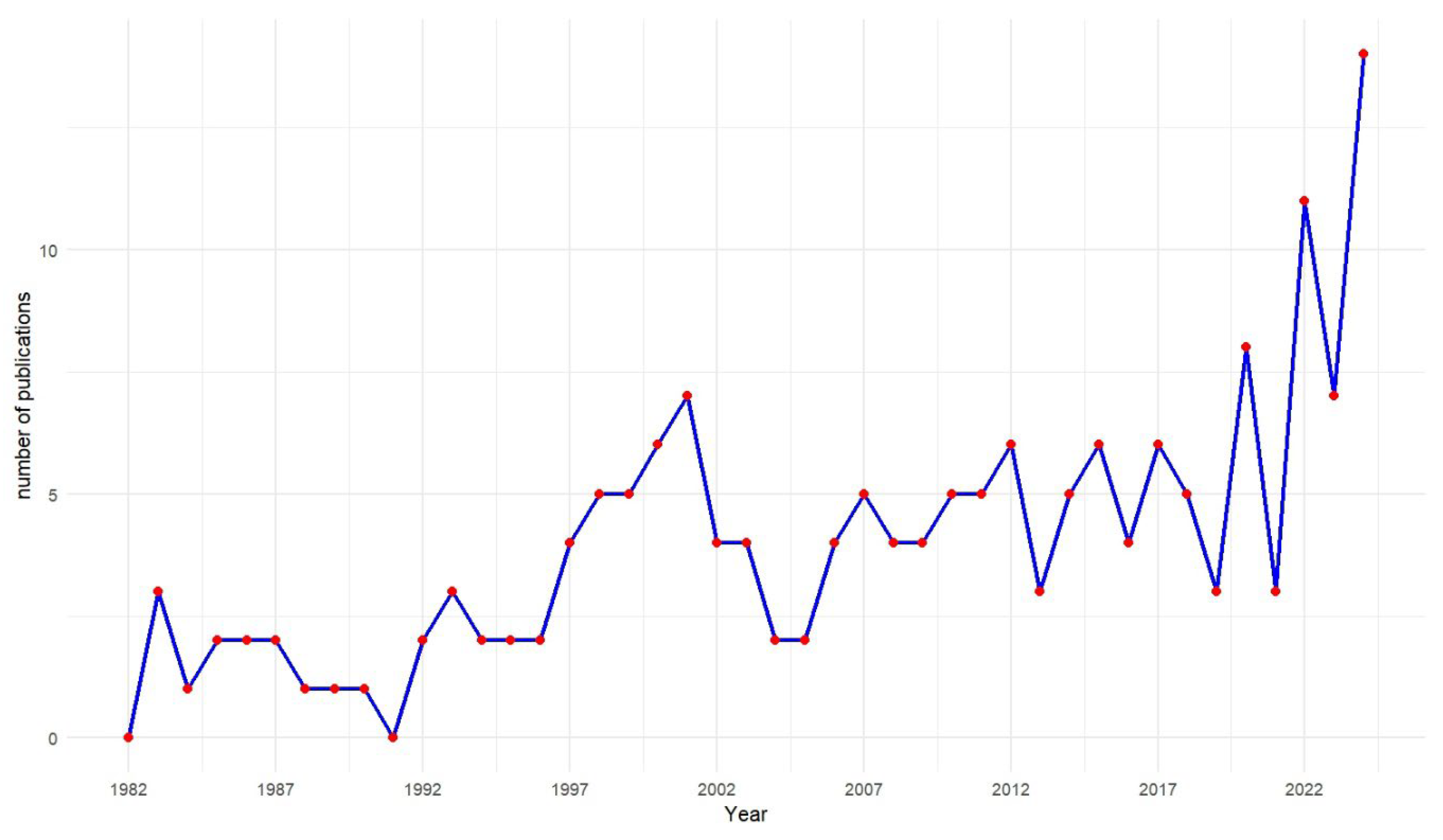

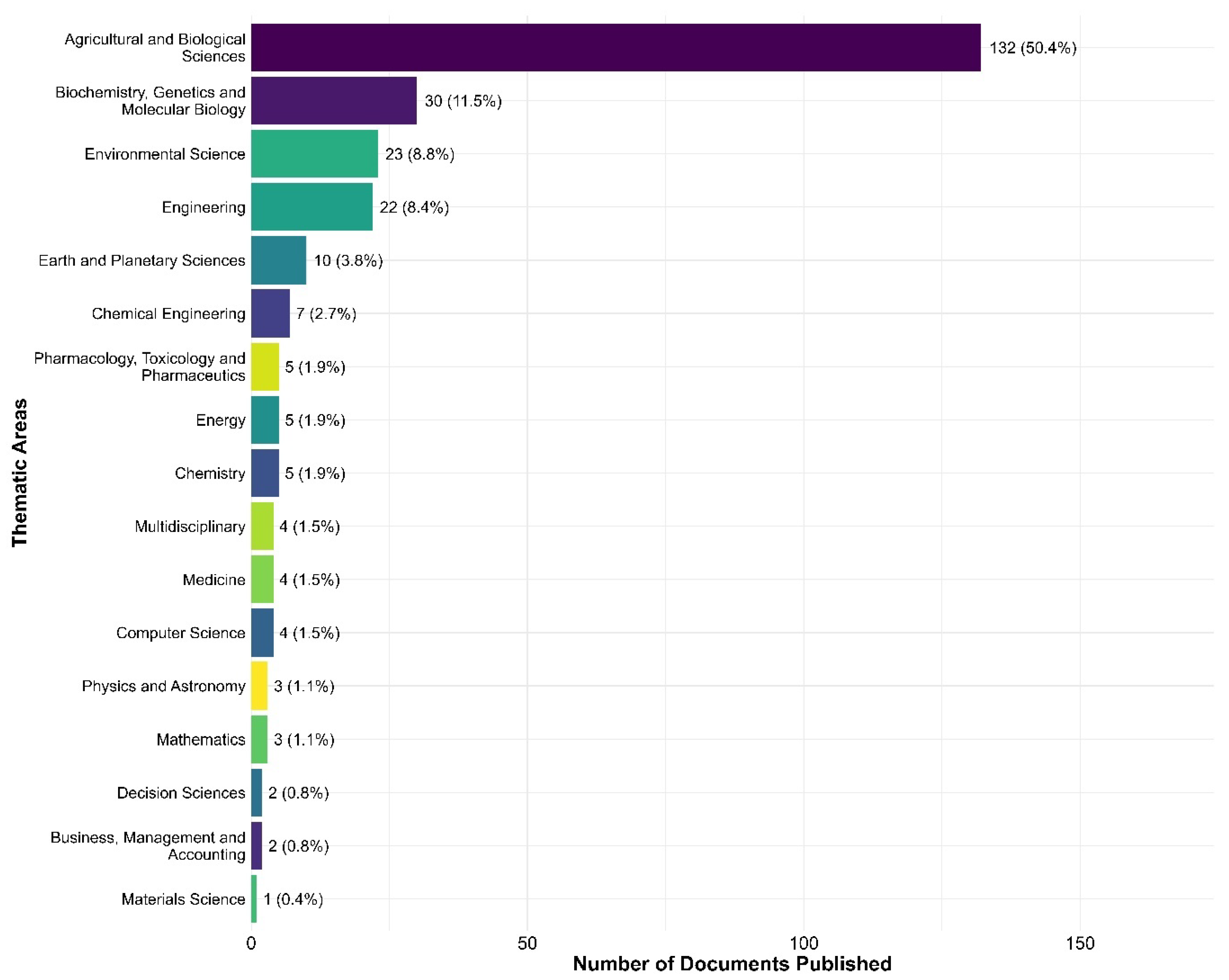
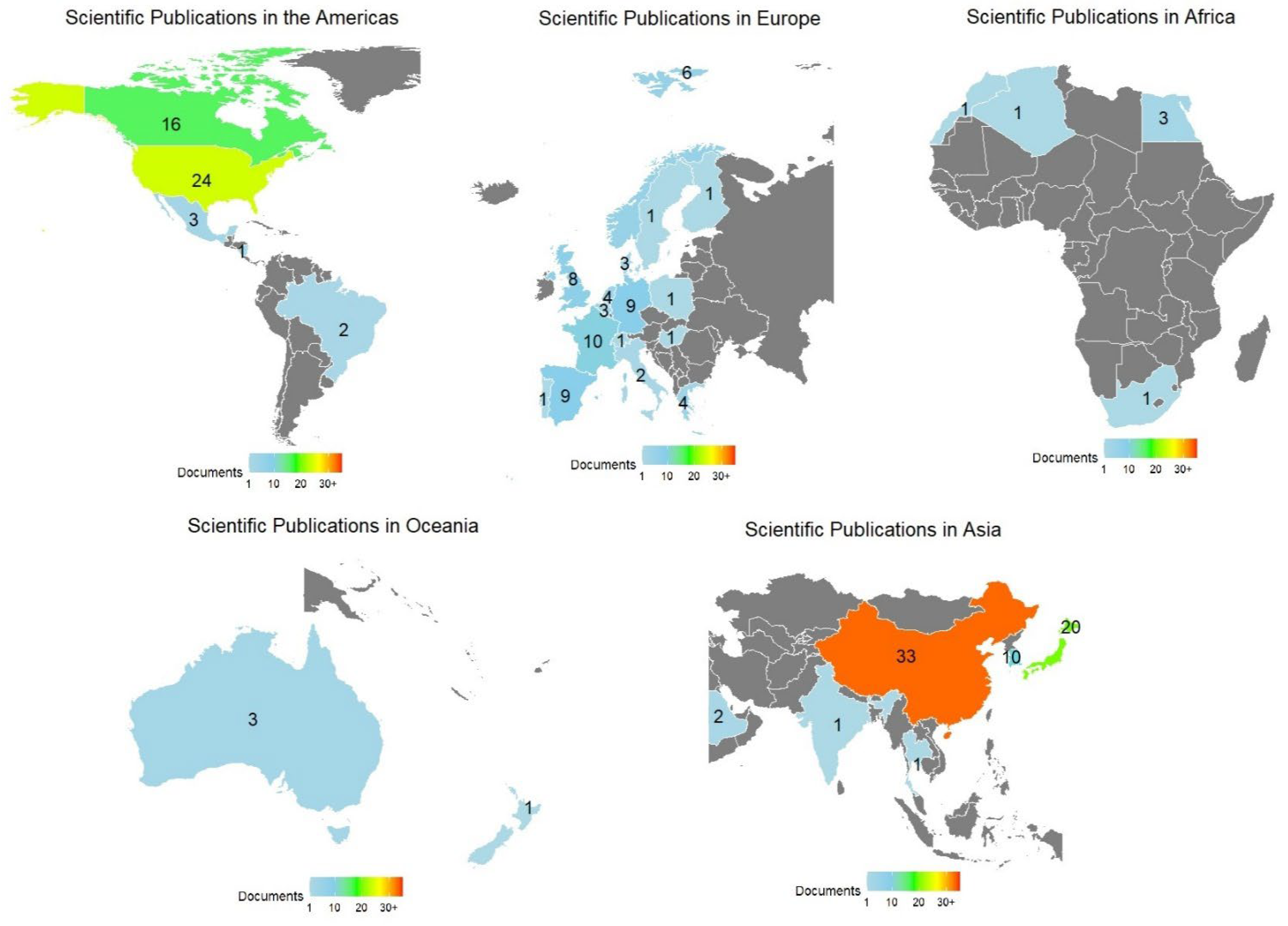

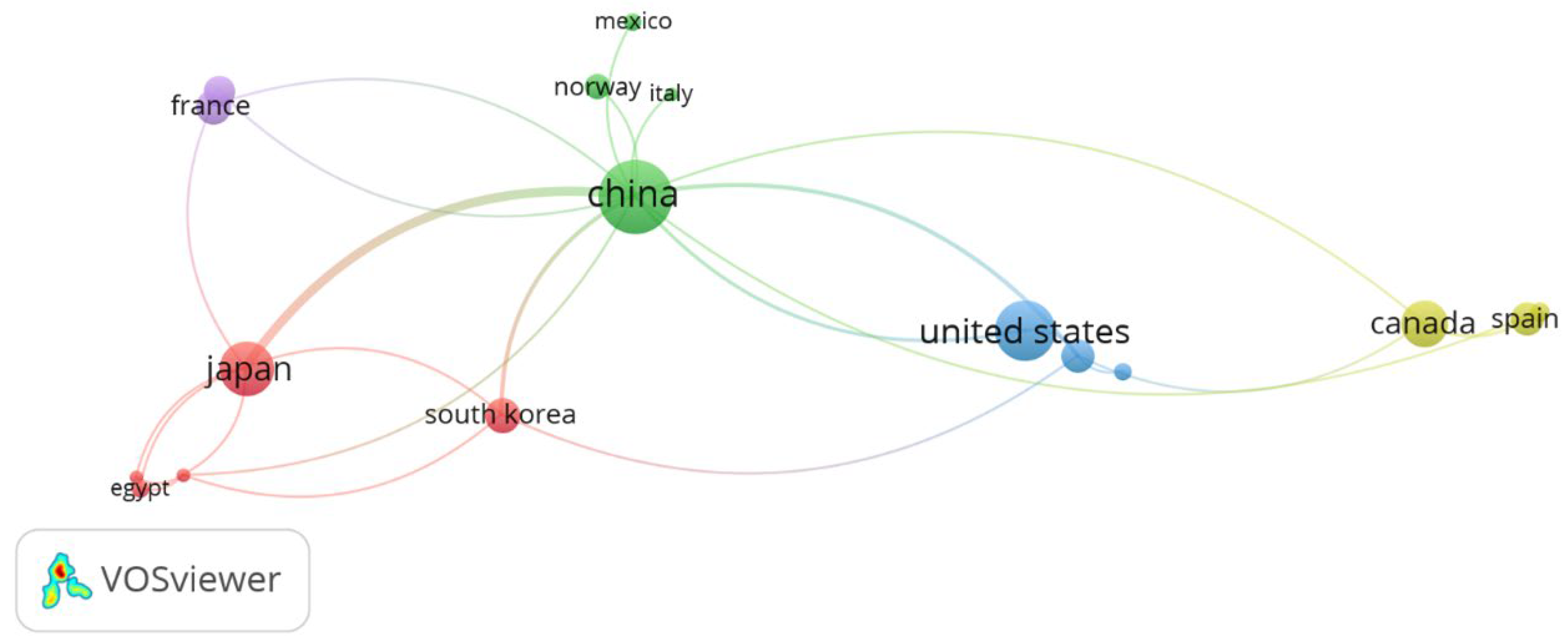
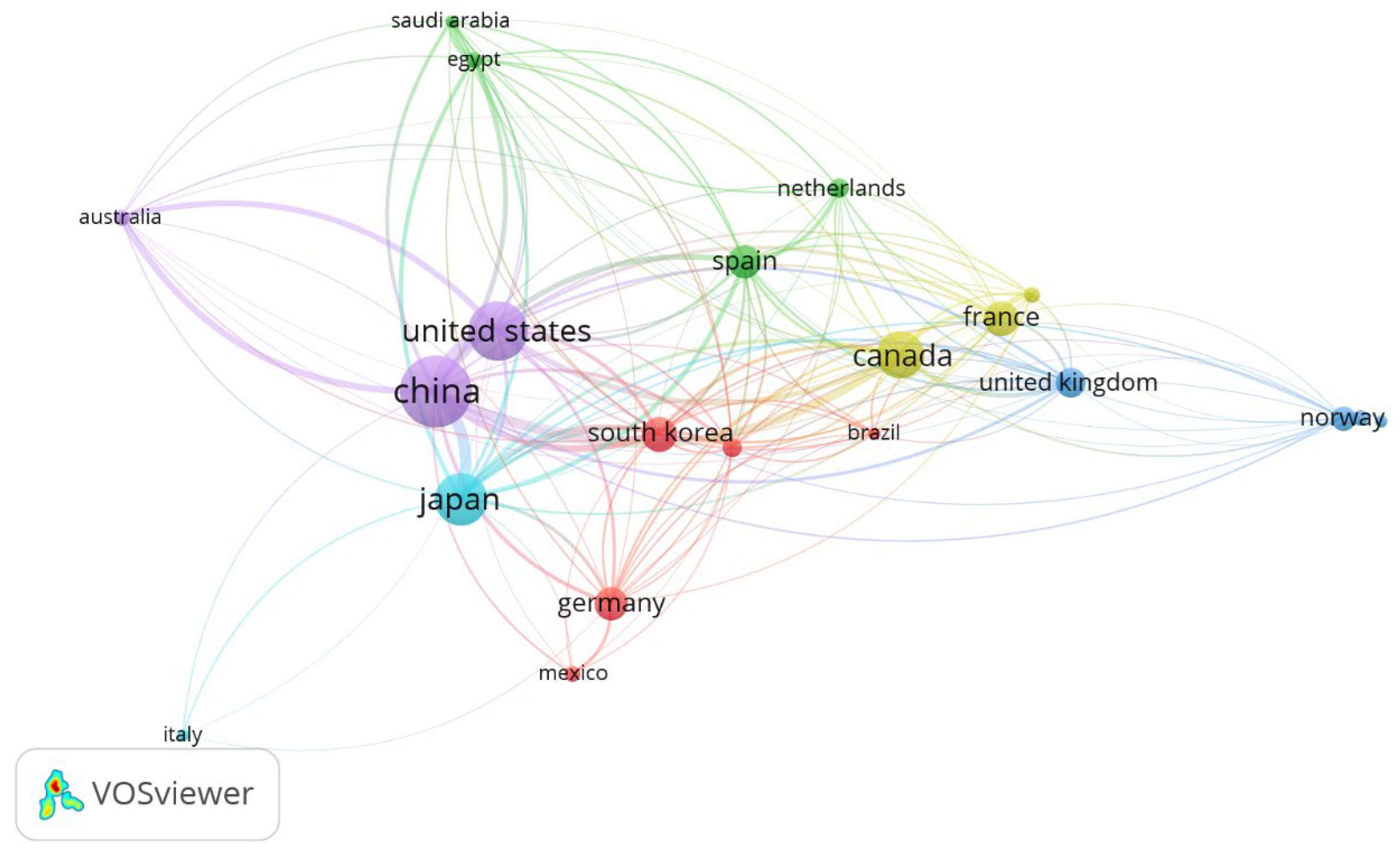
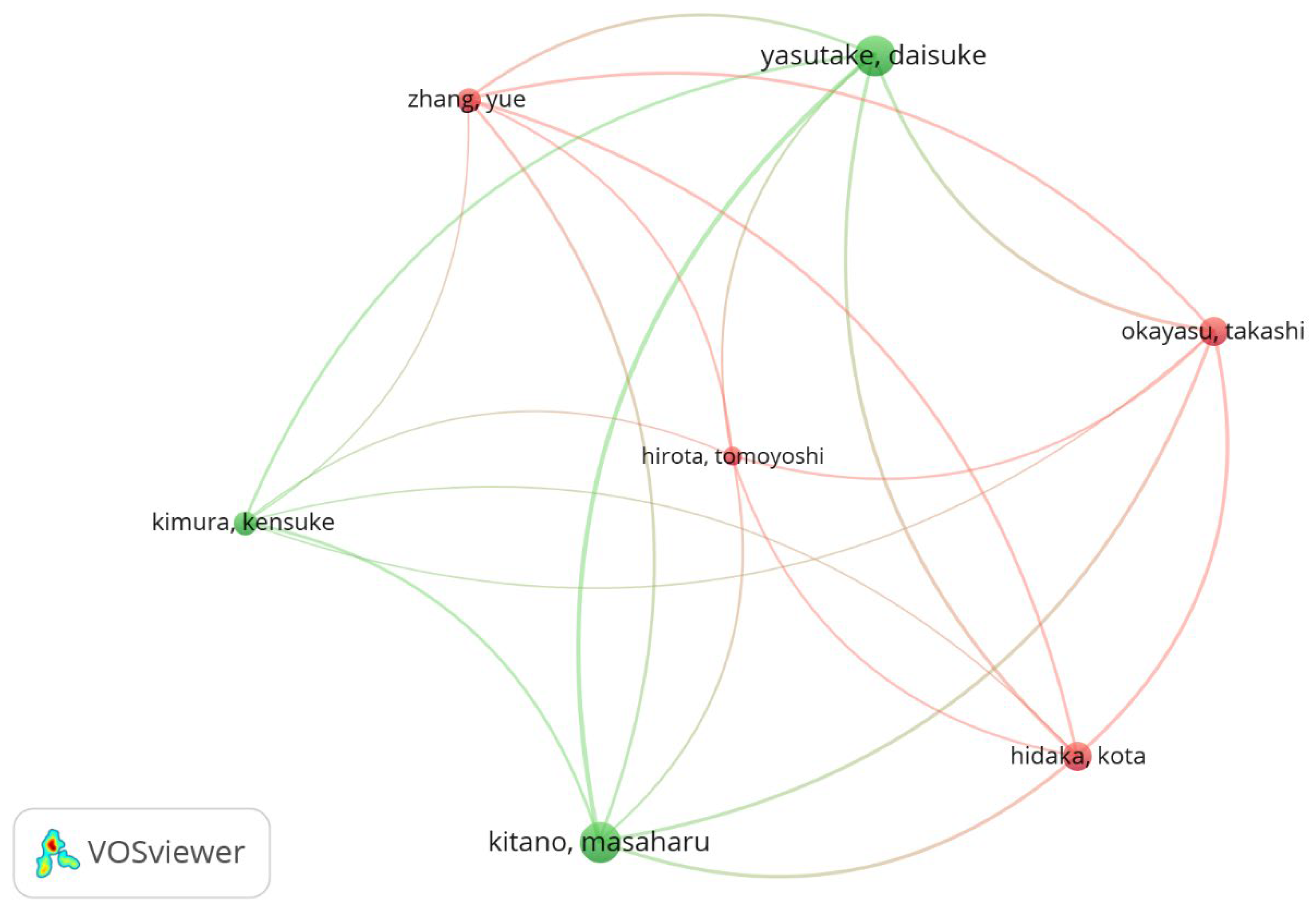

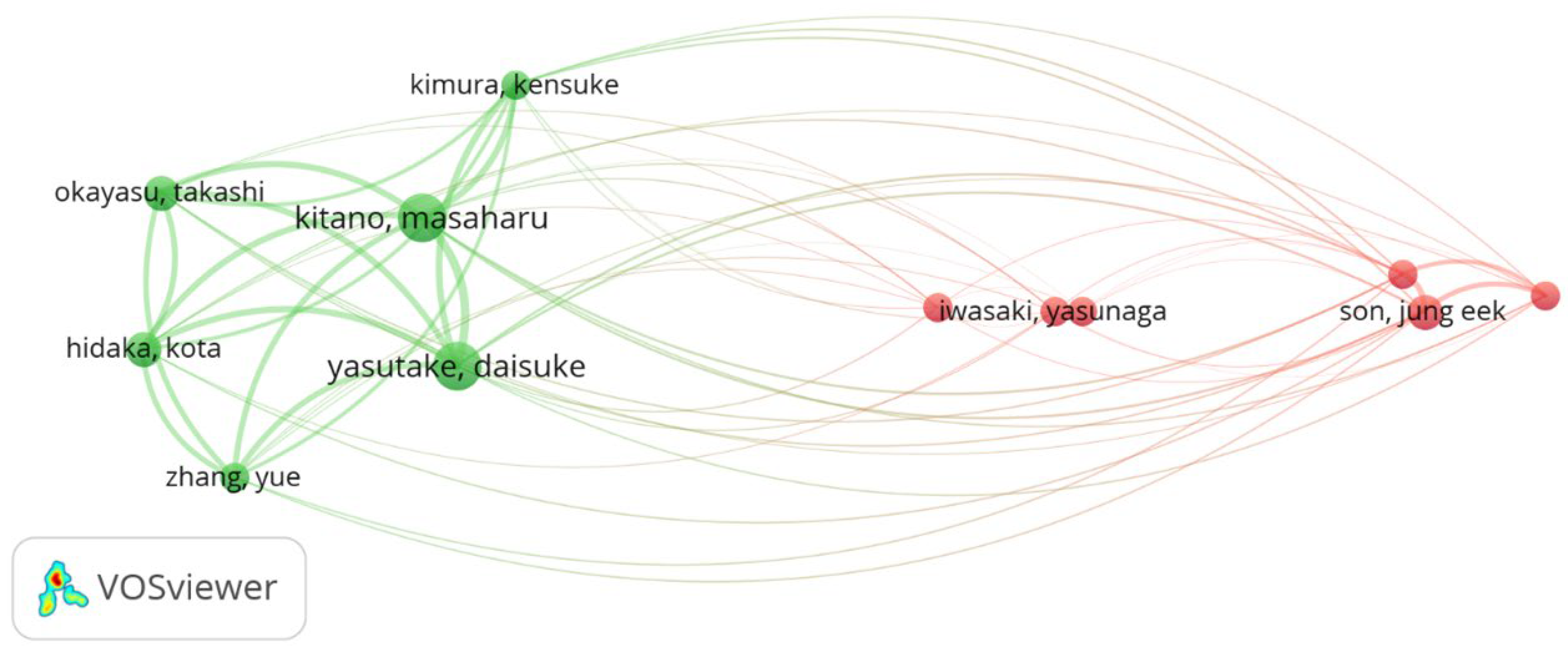

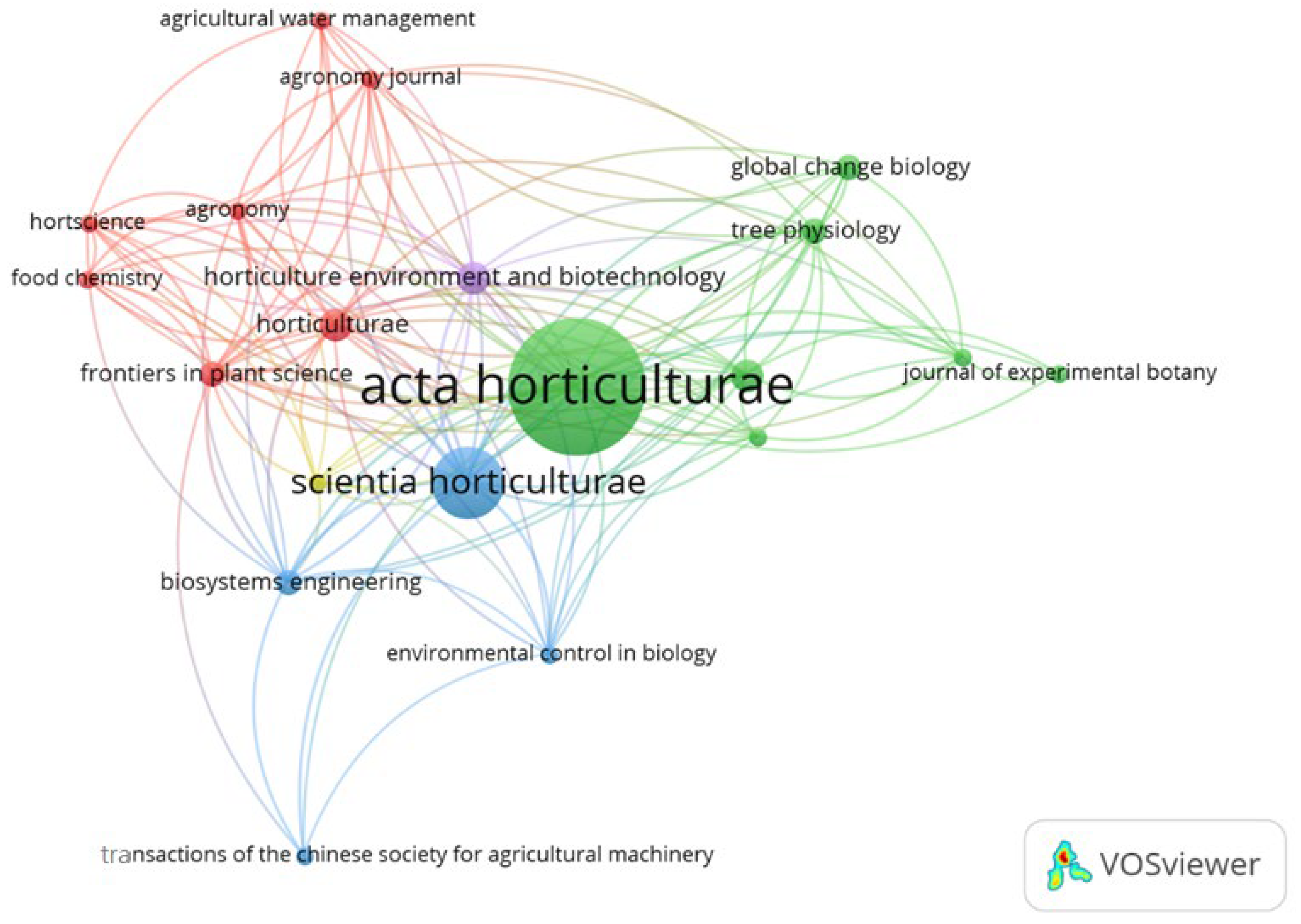
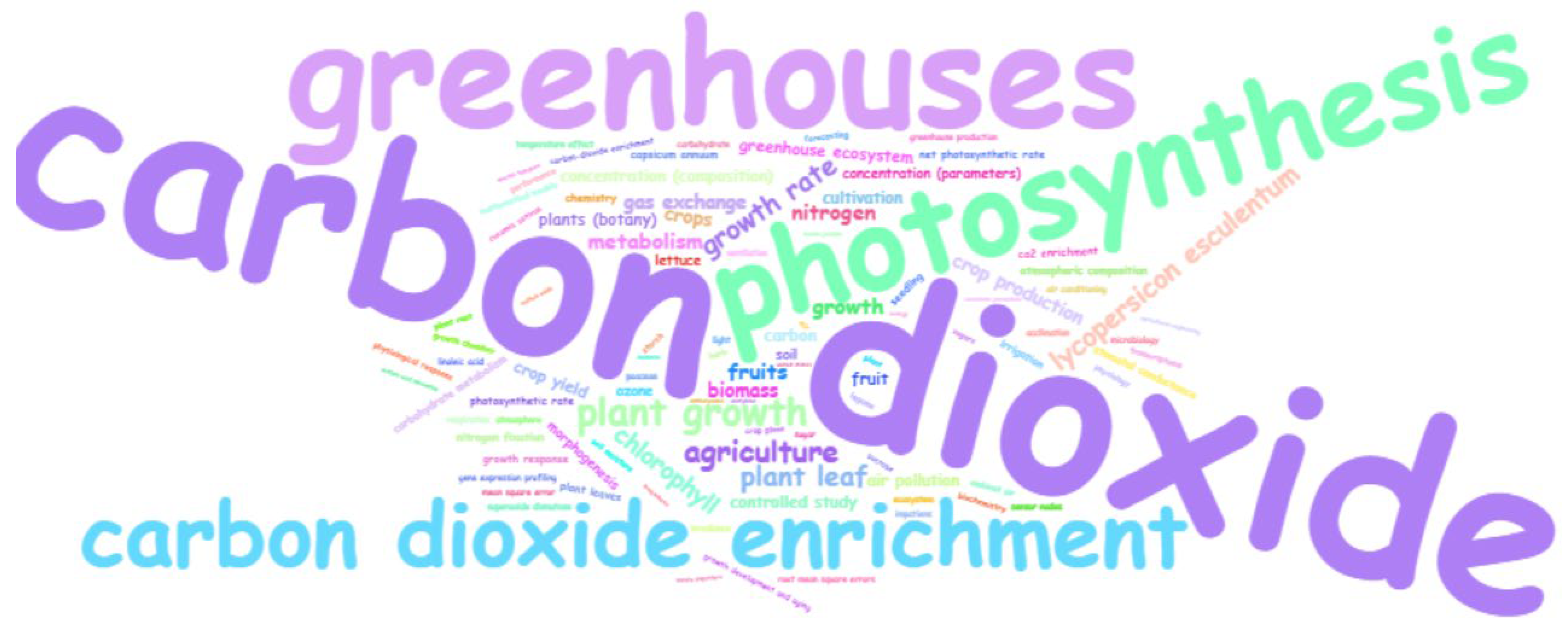
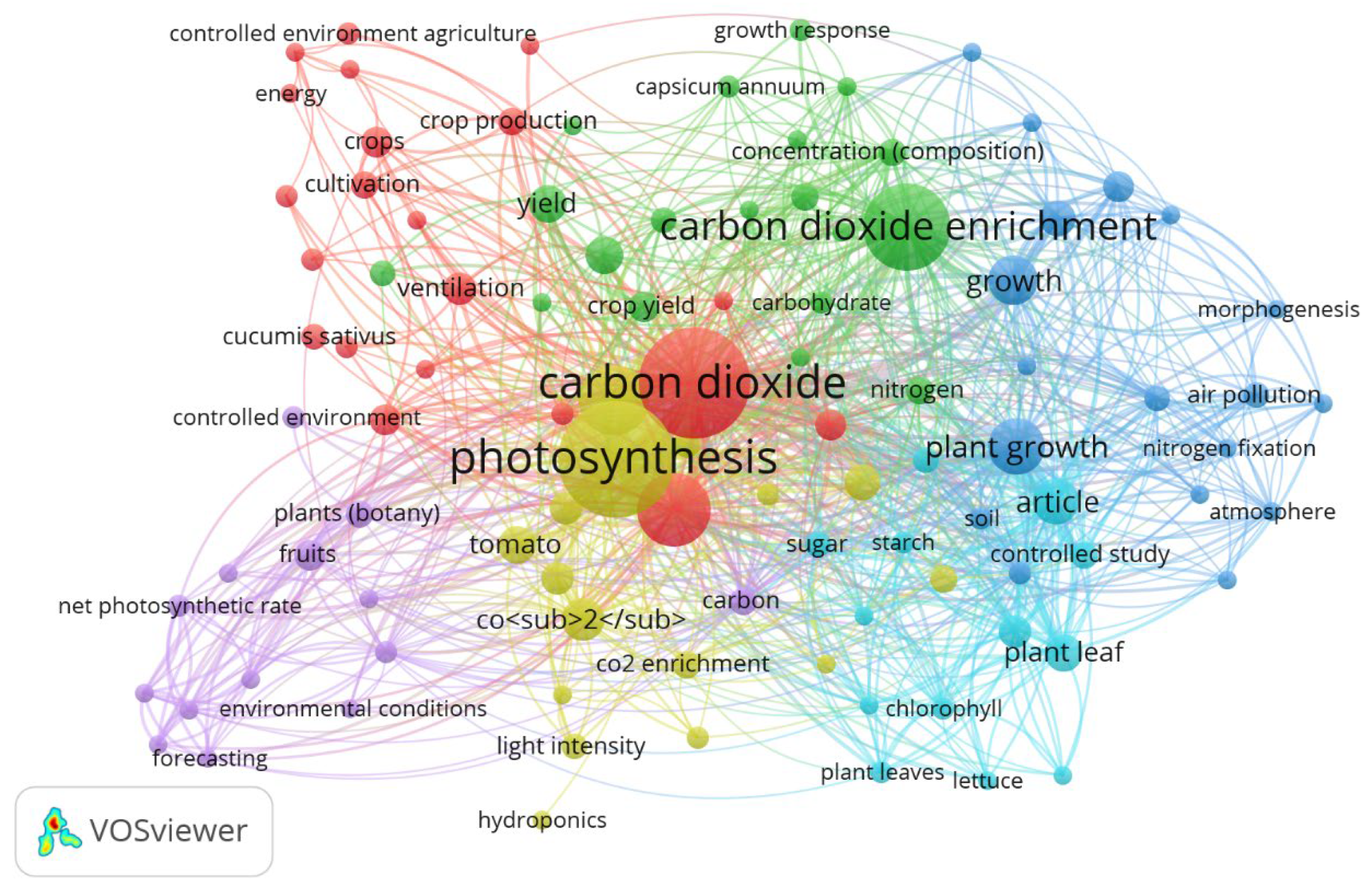

| Institution | Number of Documents Published | Website |
|---|---|---|
| Kyushu University | 7 | https://www.kyushu-u.ac.jp/en/ |
| China Agricultural University | 7 | https://en.cau.edu.cn/ |
| Seoul National University | 7 | https://en.snu.ac.kr/index.html |
| Ministry of Education of the People’s Republic of China | 6 | http://en.moe.gov.cn/ |
| Norges Miljø- og Biovitenskapelige Universitet | 6 | https://www.nord.no/ |
| Kochi University | 6 | https://www.kochi-u.ac.jp/english/ |
| National Agriculture and Food Research Organization, NARO | 6 | https://www.naro.go.jp/english/ |
| INRAE | 6 | https://www.inrae.fr/en |
| Agriculture and Agri-Food Canada | 5 | https://agriculture.canada.ca/en |
| Ministry of Agriculture of the People’s Republic of China | 5 | http://english.moa.gov.cn/ |
| Author | Number of Documents | Total Citations | H-Index | Affiliation | Country |
|---|---|---|---|---|---|
| Kitano, Masaharu | 7 | 1153 | 16 | Kochi University | Japan |
| Yasutake, Daisuke | 7 | 966 | 15 | Kyushu University | Japan |
| Hidaka, Kota | 4 | 552 | 14 | Kyushu Okinawa Agricultural Research Center NARO | Japan |
| Mortensen, Leiv M. | 4 | 2143 | 26 | Bicotec As, Sandnes | Norway |
| Okayasu, Takashi | 4 | 1106 | 19 | Kyushu University | Japan |
| Son, Jung Eek | 4 | 1866 | 22 | Seoul National University | South Korea |
| Gosselin, André | 3 | 3544 | 33 | Université Laval | Canada |
| Hwang, Inha | 3 | 128 | 7 | Seoul National University | South Korea |
| Iwasaki, Yasunaga | 3 | 339 | 10 | Meiji University | Japan |
| Jung, Dae-ho | 3 | 176 | 7 | Yonam College | South Korea |
| Journal | No. Documents | Publisher | SJR Ranking | H-Index | Country |
|---|---|---|---|---|---|
| Acta Horticulturae | 24 | International Society for Horticultural Science | Q4 | 71 | Belgium |
| Scientia Horticulturae | 11 | Elsevier B.V. | Q1 | 145 | Netherlands |
| Horticulturae | 4 | Multidisciplinary Digital Publishing Institute (MDPI) | Q1 | 36 | Switzerland |
| Horticulture Environment and Biotechnology | 4 | Springer Science + Business Media | Q1 | 40 | South Korea |
| Journal of the American Society for Horticultural Science | 4 | American Society for Horticultural Science | Q2 | 94 | United States |
| Biosystems Engineering | 3 | Elsevier B.V. | Q1 | 132 | United States |
| Frontiers in Plant Science | 3 | Frontiers Media SA | Q1 | 216 | Switzerland |
| Global Change Biology | 3 | Wiley-Blackwell Publishing Ltd. | Q1 | 313 | United Kingdom |
| Journal of Herbs, Spices and Medicinal Plants | 3 | Taylor and Francis Ltd. | Q3 | 34 | United States |
| Tree Physiology | 3 | Oxford University Press | Q1 | 147 | United Kingdom |
| Document | Title | Citations | Reference | Journal |
|---|---|---|---|---|
| 1 | Review: CO2 enrichment in greenhouses. Crop responses | 236 | [97] | Scientia Horticulturae |
| 2 | Interactive effects of increased pCO2, temperature and irradiance on the marine coccolithophore Emiliania huxleyi (Prymnesiophyceae) | 225 | [144] | European Journal of Phycology |
| 3 | Growth in elevated CO2 protects photosynthesis against high-temperature damage | 133 | [145] | Plant Cell & Enviroment |
| 4 | Nutrient relations in calcareous grassland under elevated CO2 | 83 | [146] | Oecologia |
| 5 | CO2 enrichment can produce high red leaf lettuce yield while increasing most flavonoid glycoside and some caffeic acid derivative concentration | 74 | [21] | Food Chemistry |
| 6 | Automatic carbon dioxide enrichment strategies in the greenhouse: A review | 70 | [93] | Biosystems Engineering |
| 7 | Tight coupling of root-associated nitrogen fixation and plant photosynthesis in the salt marsh grass Spartina alterniflora and carbon dioxide enhancement of nitrogenase activity | 63 | [147] | Applied and Environmental Microbiology |
| 8 | Photosynthetic acclimation to elevated atmospheric carbon dioxide and UV irradiation in Pinus banksiana | 56 | [148] | Physiologia Plantarum |
| 9 | Modelling CO2-enrichment effects using an interactive vegetation SVAT scheme | 50 | [149] | Agricultural and Forest Meteorology |
| 10 | Effects of CO2 enrichment on photosynthesis and growth in Gerbera jamesonii | 49 | [150] | Scientia Horticulturae |
Disclaimer/Publisher’s Note: The statements, opinions and data contained in all publications are solely those of the individual author(s) and contributor(s) and not of MDPI and/or the editor(s). MDPI and/or the editor(s) disclaim responsibility for any injury to people or property resulting from any ideas, methods, instructions or products referred to in the content. |
© 2025 by the authors. Licensee MDPI, Basel, Switzerland. This article is an open access article distributed under the terms and conditions of the Creative Commons Attribution (CC BY) license (https://creativecommons.org/licenses/by/4.0/).
Share and Cite
Espitia, J.J.; Amado, G.; Rodriguez, J.; Gomez, L.; Gil, R.; Flores-Velasquez, J.; Baeza, E.; Aguilar, C.E.; Akrami, M.; Arias, L.A.; et al. CO2 Enrichment in Protected Agriculture: A Bibliometric Review on Greenhouses, Controlled Environment Systems, and Vertical Farms—Part 1. Horticulturae 2025, 11, 476. https://doi.org/10.3390/horticulturae11050476
Espitia JJ, Amado G, Rodriguez J, Gomez L, Gil R, Flores-Velasquez J, Baeza E, Aguilar CE, Akrami M, Arias LA, et al. CO2 Enrichment in Protected Agriculture: A Bibliometric Review on Greenhouses, Controlled Environment Systems, and Vertical Farms—Part 1. Horticulturae. 2025; 11(5):476. https://doi.org/10.3390/horticulturae11050476
Chicago/Turabian StyleEspitia, John Javier, Gina Amado, Jader Rodriguez, Luisa Gomez, Rodrigo Gil, Jorge Flores-Velasquez, Esteban Baeza, Cruz Ernesto Aguilar, Mohammad Akrami, Luis Alejandro Arias, and et al. 2025. "CO2 Enrichment in Protected Agriculture: A Bibliometric Review on Greenhouses, Controlled Environment Systems, and Vertical Farms—Part 1" Horticulturae 11, no. 5: 476. https://doi.org/10.3390/horticulturae11050476
APA StyleEspitia, J. J., Amado, G., Rodriguez, J., Gomez, L., Gil, R., Flores-Velasquez, J., Baeza, E., Aguilar, C. E., Akrami, M., Arias, L. A., & Villagran, E. (2025). CO2 Enrichment in Protected Agriculture: A Bibliometric Review on Greenhouses, Controlled Environment Systems, and Vertical Farms—Part 1. Horticulturae, 11(5), 476. https://doi.org/10.3390/horticulturae11050476










